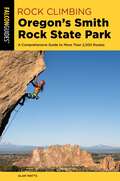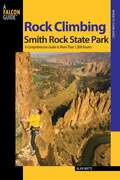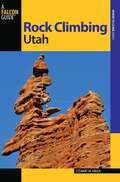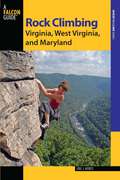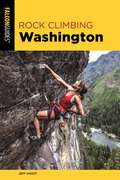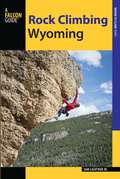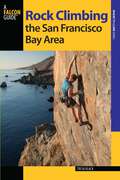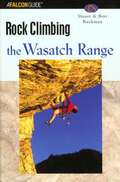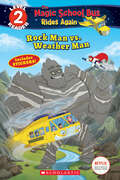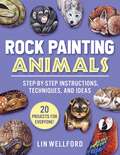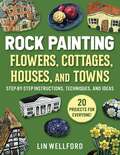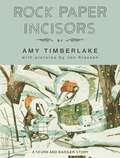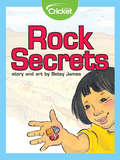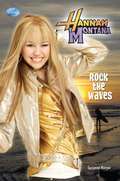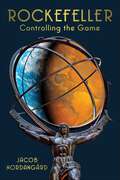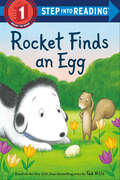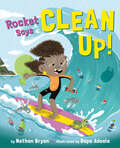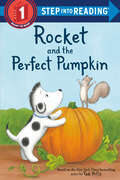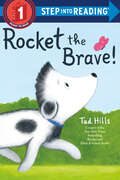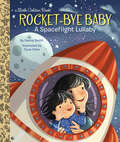- Table View
- List View
Rock Climbing Oregon's Smith Rock State Park: A Comprehensive Guide to More Than 2,200 Routes (Regional Rock Climbing Series)
by Alan WattsSmith Rock State Park. It was on the impressive crags of this Oregon hideaway that American sport climbing came into its own, and to this day, some of the hardest climbs in the United States are found on these walls. Alan Watts, who has played a leading role in the development of this popular rock-climbing destination, details more than 2,200 routes at Smith Rock and the surrounding area. This new edition updates hundreds of routes and has new photos of the many crags, walls, and routes. No other guide is as comprehensive or thorough, and no author more respected for his intimate knowledge of one of the world&’s most popular climbing destinations. To download a route index of the climbs featured in this book with difficulty ratings, place this URL in your browser: https://bit.ly/SmithRockRoutes
Rock Climbing Smith Rock State Park: A Comprehensive Guide To More Than 1,800 Routes (Regional Rock Climbing Series)
by Alan WattsThe comprehensive guide to the place that brought sport climbing to North America—a full-color, thoroughly updated new editionSmith Rock State Park. It was on the impressive crags of this Oregon hideaway that American sport climbing came into its own, and to this day, some of the hardest climbs in the United States are found on these walls. Alan Watts, who has played a leading role in the development of this popular rock-climbing destination, details more than 1,700 routes at Smith Rock and the surrounding area. This new edition updates hundreds of routes, includes hundreds of new ones, and has new photos of each crag, wall, and route. No other guide is as comprehensive or thorough, and no author more respected for his intimate knowledge of one of the world&’s most popular climbing destinations.
Rock Climbing Tuolumne Meadows (Regional Rock Climbing Series)
by Don Reid Chris FalkensteinTuolumne Meadows is famous for its clean rock, clear skies, and fabulous face and crack climbing on spectacular Sierra Nevada granite domes. In this thoroughly revised fourth edition of Rock Climbing Tuolumne Meadows, Don Reid and Chris Falkenstein share their extensive knowledge of this popular, high-country climbing area. Part of Yosemite National Park, Tuolumne Meadows, at an elevation of 8,500 feet, is often uncrowded and cool in the summer, providing an invigorating option to climbing areas at lower elevations. This is the only guidebook climbers will need to a pristine climbing experience on some of the finest rock in the world.
Rock Climbing Utah (State Rock Climbing Series)
by Stewart M. GreenUtah is a magnificent landscape of startling diversity and beauty, manifested for climbers in more cliff miles of exposed rock than any other state. Fragile sandstone towers pierce the sky amid endless miles of vertical cliffs sometimes more than a half mile high; wondrous canyon walls of cobblestone and limestone overhang at dizzying angles; and granite domes and slabs recline on sunny mountain slopes. Rock Climbing Utah is the only guide available that covers all the major climbing areas in the state. Traditional and sport climbers from the beginner to expert will find a superb sampling of hundreds of routes in the 25 areas covered--including 300 new routes that were not in the first edition. This fully revised and expanded guidebook offers first-hand information for climbers, including area overviews and climbing histories, route betas and topos, color maps and photos, equipment recommendations, approach and descent information, and listings for shops, gyms, and guide services. Stunning action photos round out the package to make Rock Climbing Utah an essential source for visitng and local climbers alike.
Rock Climbing Virginia, West Virginia, and Maryland (State Rock Climbing Series)
by Stewart M. Green Eric HorstThis revised and updated guidebook--now in full color--provides rock climbers with information on the best climbs in Virginia, West Virginia, and Maryland, accompanied with color action photographs, climbing history for each area, route ratings and trip planning information, pitch-by-pitch written descriptions, detailed color topos and clear overview photos, descent information and gear recommendations.
Rock Climbing Washington (State Rock Climbing Series)
by Jeff SmootThis updated edition of Rock Climbing Washington features more than 1,500 routes throughout the state of Washington. Explore the granite cliffs of Index, Leavenworth, Darrington, and Tieton River Canyon; tackle the exposed alpine routes on the spires at Washington Pass; or hang from steep sport climbs at North Bend, Frenchman Coulee, and Marcus and China Bend near Spokane.
Rock Climbing Wyoming: The Best Routes in the Cowboy State (How To Climb Series)
by Sam LightnerRock Climbing Wyoming describes 11 major climbing areas in the state of Wyoming. It offers approximately 550 climbing routes for beginners and experts alike. Maps, color topos, and stunning action photos accompany clearly written descriptions of the routes to make this an indispensable resource for the best climbing in "Wonderful Wyoming".
Rock Climbing the San Francisco Bay Area (Regional Rock Climbing Series)
by Tresa BlackRock Climbing the San Francisco Bay Area offers options for multiple ascents in more than 20 areas around the San Francisco Bay. In addition to the nuts and bolts of routes and ratings, information on coffee shops, and brewpubs, and other amenities in each area is included, along with notes on where rock climbers can take their four-footed climbing partners. Photographs, topos, and maps accompany the text.
Rock Climbing the Wasatch Range (Regional Rock Climbing Series)
by Bret Ruckman Stuart RuckmanThis book compiles the results of 70 years of rock climbing in Utah's Wasatch Range, including Little Cottonwood Canyon, Big Cottonwood Canyon, Lone Peak, and other climbing locales near Salt Lake City. It features detailed topos, route descriptions, difficulty and quality ratings, and accurate location maps. Indexes by route name and rating allow quick access to over 1,500 routes described in this authoritative volume.
Rock Climbing: The Art of Safe Ascent
by John Long Bob GainesWritten by world renowned rock climbers and veteran Falcon authors John Long and Bob Gaines, this comprehensive volume will be the go-to resource for the necessities of rock climbing safety. By stressing both fundamentals and state-of-the-art techniques, it will be a great resource for both beginners and experienced climbers looking to brush up on their skills.
Rock Man vs. Weather Man: Scholastic Reader, Level 2 (The Magic School Bus Rides Again)
by Samantha BrookeNext stop . . . The Magic School Bus travels back in time to learn about the rock cycle! Ms. Frizzle’s class is creating a time capsule. Tim wants to add an original superhero comic book, but he doesn’t know what to write about. When the Magic School Bus takes the class on an adventure across millions of years to learn about the incredible rock cycle, Tim gets an idea. It’s the epic battle between Captain Rockman vs. Weatherman. Who will win? This exciting novel continues the adventures of the Magic School Bus, the inspiration for the Emmy Award–winning animated series that has now been revived by Netflix.
Rock Painting Animals: Step-by-Step Instructions, Techniques, and Ideas—20 Projects for Everyone!
by Lin WellfordPerfect for kids, crafters, and animal lovers, this fun guide will teach you how to paint your favorite wild animals and family pets on stones! New painters wanted! No experience necessary! With Lin Wellford&’s instruction, thousands have discovered the thrill of turning rocks into works of art. Her bestselling books have helped to awaken interest in modern rock painting. It's the perfect hobby—fast, fun, and inexpensive.Rock Painting Animals offers a variety of easy projects designed to introduce basic painting techniques yet still appeal to seasoned painters. Learn to paint your favorite animals, including:CatsKittensDogsDeerFishFoxesGuinea PigsLadybugsOwlsParrotsRabbitsRaccoonsSnakesTurtlesWith tips on how to translate an animal's features into simple geometric shapes that maintain proper proportion and perspective, these projects will have you purring with delight. Grab a brush, find a stone, and get ready to rock! Experience the magic of this fun and exciting art activity.
Rock Painting Flowers, Cottages, Houses, and Towns: Step-by-Step Instructions, Techniques, and Ideas—20 Projects for Everyone
by Lin WellfordPerfect for kids and crafters, this fun guide will teach you how to paint flowers, cottages, houses, and towns on stones! New painters wanted! No experience necessary! With Lin Wellford&’s instruction, thousands have discovered the thrill of turning rocks into works of art. Her bestselling books have helped to awaken interest in modern rock painting. It's the perfect hobby—fast, fun, and inexpensive.Rock Painting Flowers, Cottages, Houses, and Towns offers a variety of easy projects designed to introduce basic painting techniques yet still appeal to seasoned painters. Learn to paint your favorite scenery elements, including:DaisiesTulipsPetuniasDaffodilsPansiesMumsWreaths of RosesFlower BasketsCottagesA-FramesChaletsGnome HomesBarnsCountry ChurchSmall Town ShopsFarmhousesProduce MarketsColonial Style BuildingsTudor-Style HomesVictorian MansionsRock VillagesWith tips on how to translate an animal's features into simple geometric shapes that maintain proper proportion and perspective, these projects will brighten any home or garden. Grab a brush, find a stone, and get ready to rock! Experience the magic of this fun and exciting art activity.
Rock Paper Incisors: A Skunk and Badger Story (Skunk and Badger)
by Amy TimberlakeShake off the hibernation blues with odd-couple friends Skunk and Badger in this funny and bestselling series, from Amy Timberlake and Jon Klassen! Skunk and Badger have an easy roommate rhythm—Skunk cooks! Badger cleans!—until they take in two orphaned rat pups, Zeno and Zephyr. Badger is working on an Important Rock Work article for Rock Hound Weekly and needs focus, focus, focus to write it. How much trouble could two tiny rats really be? Some scheduling, a few strategically placed naps, and all will be well! But it&’s winter, and nothing goes to plan. Hibernation threatens every routine. Articles refuse to write themselves. And rats in the rock room? It will take a North Twist village to raise these rats! Featuring cozy drawings and full-color pictures by bestselling artist Jon Klassen, Amy Timberlake&’s delightfully off-kilter adventure explores the complexity of friendship and the meaning of family in a wintery world where chickens wear parkas and Yard Sheep host spaghetti dinners. And wait! Is that a dinosaur?Don't miss Skunk and Badger's other adventures in:Skunk and BadgerEgg Marks the Spot
Rock Secrets
by Betsy JamesEvery single rock has a secret story to tell about what the earth was like long ago.
Rock the Waves (Disney's Hannah Montana)
by Suzanne Harper"The Surf Series" is coming to Malibu, and that means boards, boys, and summer concerts. For Hannah it also means a summer of drama and romance, in this all-new, original novel based on the top-rated Disney series "Hannah Montana".
Rock | Water | Life: Ecology and Humanities for a Decolonial South Africa
by Lesley GreenIn Rock | Water | Life Lesley Green examines the interwoven realities of inequality, racism, colonialism, and environmental destruction in South Africa, calling for environmental research and governance to transition to an ecopolitical approach that could address South Africa's history of racial oppression and environmental exploitation. Green analyzes conflicting accounts of nature in environmental sciences that claim neutrality amid ongoing struggles for land restitution and environmental justice. Offering in-depth studies of environmental conflict in contemporary South Africa, Green addresses the history of contested water access in Cape Town; struggles over natural gas fracking in the Karoo; debates about decolonizing science; the potential for a politics of soil in the call for land restitution; urban baboon management; and the consequences of sending sewage to urban oceans.
Rock, Paper, Scissors: Simple, Thrifty, Fun Activities to Keep Your Family Entertained All Year Round
by Kate HodgesRock, Paper, Scissors is a collection of creative, fun, sense-stimulating things you can do with very simple materials: stones, paper and scissors.From land art to science experiments, with a pinch of geology, and a sprinkling of magic, these easy-but-inspiring and thrifty activities will keep your family occupied all year round.Rock, Paper, Scissors is packed with activities to do indoors and outdoors, in the city, at the beach, in the countryside – wherever you might be. Perfect for parents who are keen to turn walks and day trips into exciting experiences, this activity book will have universal appeal for families who want to reduce their screen time and encourage kids to conjure up adventures from almost nothing both indoors and out.
Rockefeller: Controlling the Game
by Jacob NordangårdWhy would the first family of oil so ardently support environmental climate research and activism? Join author and researcher Jacob Nordangård as he uncovers the whole sordid truth. The Rockefeller family is one of the richest in the world. Yet, why would the family that made the world dependent on oil fund environmental and climate research since the 1950s, help shape climate policy measures since the 1980s, and supported climate activism since the 1990s? Rockefeller: Controlling the Game is the thrilling and paradoxical story of one of the world's most influential global players. Through its top position in American business, close contacts with the White House, and with their immense financial power as one of the world's leading private research funders, the Rockefellers have been able to anchor the climate issue both scientifically and politically. Yet what is the reasoning behind doing so? Author and researcher Jacob Nordangård follows the family from the founding of Standard Oil and the Rockefeller Foundation, up through the aftermath of the Paris Agreement, with the declaration of the Fourth Industrial Revolution in January 2016, to the present day. Nordangård's in-depth research includes the large quantities of new material recently made available on the Internet, as well as the Rockefeller Foundation's own annual reports. Nordangård's main focus is the Rockefeller family's involvement in climate research and politics, but the actions and motives of some of their allies are also explored, as well as the family's influence on the development of modern medicine, family planning, agriculture, art, architecture, behavioral science, information technology, and politics. The Rockefeller family's utopian dream of a perfect world will have serious consequences for the survival of the human species and life as we know it. The Rockefeller Foundation's stated mission to "promote the well-being of humanity throughout the world" has a dark flipside, as, Nordangård will prove, the Rockefeller family's long-standing battle against climate change contains elements of sophisticated propaganda techniques, futurism, and New Age philosophy, aiming at a complete transformation of the whole earth system, including economy, ecology, culture, and even humanity itself.
Rocket Finds an Egg (Step into Reading)
by Tad HillsKids are learning to read with Rocket! The beloved puppy from Tad Hills's New York Times bestselling picture books returns in an easy-to-read book that proves every egg has a nest.Rocket and his friend Bella find an egg! The birds in the meadow don't know whose it is. The egg is too small, too colorless, or too round to be theirs! Will the friends return the egg to its nest? With its simple words, lots of repetition, and bright, colorful illustrations, young readers will love this Step 1 leveled reader about Rocket, which they can ready all by themselves!Step 1 Readers feature big type and easy words. Rhymes and rhythmic text paired with picture clues help children decode the story. Perfect for early readers of Rocket the Brave and Drop it, Rocket! and children who know the alphabet and are eager to begin reading
Rocket Says Clean Up! (Rocket Says...)
by Nathan BryonPlucky science-lover Rocket returns in another inspiring picture book about getting a community to notice the world around them, and, in this book, to CLEAN UP! their shoreline.Rocket, is off to the islands to visit her grandparents. Her family loves nothing better than to beach comb and surf together...but the beach is clogged with trash! When she finds a turtle tangled in a net, Rocket decides that something must be done! Like a mini Greta Thunberg, our young activist's enthusiasm brings everyone together...to clean up the beach and prevent plastics from spoiling nature. Perfect for fans of Rocket Says Look Up! and Ada Twist, Scientist, this book is for any youngster concerned about our environment. Rocket Says Clean Up! will inspire readers of all ages to dream big and tackle problems head-on.
Rocket and the Perfect Pumpkin (Step into Reading)
by Tad HillsKids are learning to read with Rocket! Rocket, the star of Tad Hills's New York Times bestselling picture books, returns in a new Level 1 Step into Reading story, this time about the joy of being kind.It's a beautiful day at the pumpkin patch! There, Rocket and Bella find the perfect pumpkin. But as the friends try to take the pumpkin home, it rolls downhill and lands in front of Mr. Barker's doghouse. Can Rocket and Bella get their pumpkin back? With its simple words, lots of repetition, and bright, colorful illustrations, young readers will love this Step 1 Step into Reading leveled reader about being generous, which they can read all by themselves!Step 1 Readers feature big type and easy words. Rhymes and rhythmic text paired with picture clues help children decode the story. Perfect for early readers of Rocket the Brave and Drop it, Rocket! and children who know the alphabet and are eager to begin reading.Want more easy-to-read fun with Rocket? Don't miss Rocket's Very Fine Day!
Rocket the Brave! (Step into Reading)
by Tad HillsKids are learning to read with Rocket! Tad Hills the #1 New York Times bestselling author is back with another Level 1 Step into Reading story about the beloved dog Rocket, this time about overcoming fear and being brave. Rocket, the star of the New York Times bestselling picture books How Rocket Learned to Read and Rocket Writes a Story, returns in an all-new Step 1 Step into Reading leveled reader. Rocket is happily chasing a butterfly through the meadow when she disappears into the woods. As much as Rocket wants to follow the butterfly, the woods look dark and scary. Can Rocket overcome his fear? With predictable patterns, simple words, lots of repetition, and bright, colorful illustrations, young readers will love this new Rocket book, which they can read all by themselves!Step 1 Readers feature big type and easy words. Rhymes and rhythmic text paired with picture clues help children decode the story. Perfect for children who know the alphabet and are eager to begin reading.
Rocket-Bye Baby: A Spaceflight Lullaby (Little Golden Book)
by Danna SmithWhen stars begin to twinkle in the night sky, it's time for an outer-space lullaby. A perfect bedtime read to celebrate the 50th anniversary of the moon landing!Rocket-bye, Baby, up to the moon. Nighttime is falling; sleep will come soon.We'll climb in the spaceship and that's where we'll stay,snuggled up close as we're carried away. . . . Join a mother and her baby as they fly in their own little rocket through a star-filled night sky, past constellations and meteor showers, in this dreamy good-night book. A gentle rhyme and beautiful artwork of stars and planets and mother and child make this a perfect good-night book when the stars come out.
